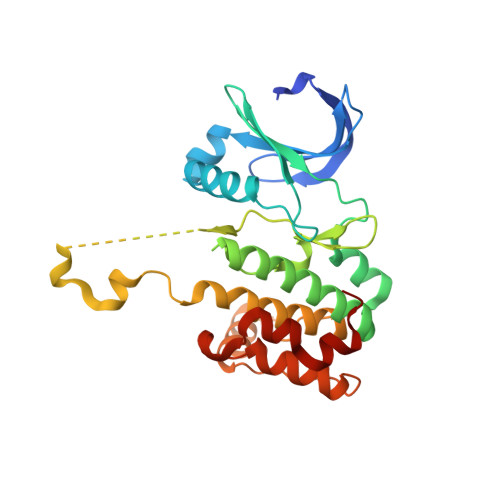Aurora A Kinase Inhibition Is Synthetic Lethal with Loss of theRB1Tumor Suppressor Gene.
Gong, X., Du, J., Parsons, S.H., Merzoug, F.F., Webster, Y., Iversen, P.W., Chio, L.C., Van Horn, R.D., Lin, X., Blosser, W., Han, B., Jin, S., Yao, S., Bian, H., Ficklin, C., Fan, L., Kapoor, A., Antonysamy, S., Mc Nulty, A.M., Froning, K., Manglicmot, D., Pustilnik, A., Weichert, K., Wasserman, S.R., Dowless, M., Marugan, C., Baquero, C., Lallena, M.J., Eastman, S.W., Hui, Y.H., Dieter, M.Z., Doman, T., Chu, S., Qian, H.R., Ye, X.S., Barda, D.A., Plowman, G.D., Reinhard, C., Campbell, R.M., Henry, J.R., Buchanan, S.G.(2019) Cancer Discov 9: 248-263
- PubMed: 30373917
- DOI: https://doi.org/10.1158/2159-8290.CD-18-0469
- Primary Citation of Related Structures:
6C2R, 6C2T - PubMed Abstract:
Loss-of-function mutations in the retinoblastoma gene RB1 are common in several treatment-refractory cancers such as small-cell lung cancer and triple-negative breast cancer. To identify drugs synthetic lethal with RB1 mutation ( RB1 mut ), we tested 36 cell-cycle inhibitors using a cancer cell panel profiling approach optimized to discern cytotoxic from cytostatic effects. Inhibitors of the Aurora kinases AURKA and AURKB showed the strongest RB1 association in this assay. LY3295668, an AURKA inhibitor with over 1,000-fold selectivity versus AURKB, is distinguished by minimal toxicity to bone marrow cells at concentrations active against RB1 mut cancer cells and leads to durable regression of RB1 mut tumor xenografts at exposures that are well tolerated in rodents. Genetic suppression screens identified enforcers of the spindle-assembly checkpoint (SAC) as essential for LY3295668 cytotoxicity in RB1-deficient cancers and suggest a model in which a primed SAC creates a unique dependency on AURKA for mitotic exit and survival. SIGNIFICANCE: The identification of a synthetic lethal interaction between RB1 and AURKA inhibition, and the discovery of a drug that can be dosed continuously to achieve uninterrupted inhibition of AURKA kinase activity without myelosuppression, suggest a new approach for the treatment of RB1-deficient malignancies, including patients progressing on CDK4/6 inhibitors. See related commentary by Dick and Li, p. 169 . This article is highlighted in the In This Issue feature, p. 151 .
Organizational Affiliation:
Eli Lilly and Company, Indianapolis, Indiana.
















